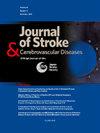生姜散通过NLRP3/Caspase-1通路改善MCAO诱导的大鼠细胞焦亡和炎症
IF 1.8
4区 医学
Q3 NEUROSCIENCES
Journal of Stroke & Cerebrovascular Diseases
Pub Date : 2025-04-26
DOI:10.1016/j.jstrokecerebrovasdis.2025.108314
引用次数: 0
摘要
本研究旨在探讨升江散缓解缺血性脑卒中的作用及其机制。方法建立模型组和给药组大鼠大脑中动脉闭塞再灌注(MCAO)模型。采用神经功能评分、TTC染色、苏木精-伊红染色、尼氏染色评价SJP对MCAO大鼠的预防和治疗作用。采用实时定量聚合酶链反应、western blotting、免疫荧光双染色检测NLRP3/Caspase-1通路相关生物标志物的表达水平。结果ssjp对MCAO大鼠脑组织损伤有改善作用。SJP抑制MCAO后大鼠NLRP3/Caspase-1通路的激活。Caspase-1在mcao后24 h主要在大鼠神经元和小胶质细胞中表达,在星形胶质细胞中表达较少。结论sjp通过抑制NLRP3/Caspase-1通路的激活来改善大鼠脑组织损伤,从而减轻MCAO诱导的炎症反应和细胞焦亡。本文章由计算机程序翻译,如有差异,请以英文原文为准。
Shengjiang powder ameliorates cell pyroptosis and inflammation induced by MCAO in rats through the NLRP3/Caspase-1 pathway
Background
This study aims to explore the effects and mechanisms of Shengjiang Powder (SJP) in alleviating ischemic stroke.
Methods
The middle cerebral artery occlusion and reperfusion (MCAO) model was established in rats for both the model and medication groups. Neurological function scores, TTC staining, Hematoxylin-Eosin staining and Nissl staining were employed to evaluate the preventive and therapeutic effects of SJP on MCAO in rats. Real-time quantitative polymerase chain reaction, western blotting, and immunofluorescence double staining were used to detect the expression levels of biological markers related to the NLRP3/Caspase-1 pathway.
Results
SJP demonstrated an improvement in brain tissue damage in rats subjected to MCAO. SJP inhibited the activation of the NLRP3/Caspase-1 pathway after MCAO in rats. Caspase-1 was primarily expressed in neurons and microglia 24 h post-MCAO in rats, with minimal expression in astrocytes.
Conclusion
SJP ameliorates brain tissue damage by inhibiting the activation of the NLRP3/Caspase-1 pathway, thereby reducing the inflammatory response and cell pyroptosis induced by MCAO in rats.
求助全文
通过发布文献求助,成功后即可免费获取论文全文。
去求助
来源期刊

Journal of Stroke & Cerebrovascular Diseases
Medicine-Surgery
CiteScore
5.00
自引率
4.00%
发文量
583
审稿时长
62 days
期刊介绍:
The Journal of Stroke & Cerebrovascular Diseases publishes original papers on basic and clinical science related to the fields of stroke and cerebrovascular diseases. The Journal also features review articles, controversies, methods and technical notes, selected case reports and other original articles of special nature. Its editorial mission is to focus on prevention and repair of cerebrovascular disease. Clinical papers emphasize medical and surgical aspects of stroke, clinical trials and design, epidemiology, stroke care delivery systems and outcomes, imaging sciences and rehabilitation of stroke. The Journal will be of special interest to specialists involved in caring for patients with cerebrovascular disease, including neurologists, neurosurgeons and cardiologists.
 求助内容:
求助内容: 应助结果提醒方式:
应助结果提醒方式:


